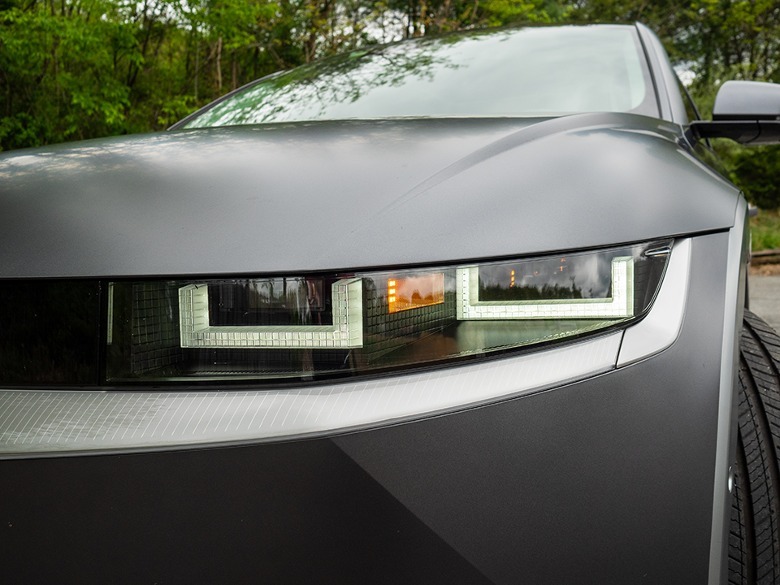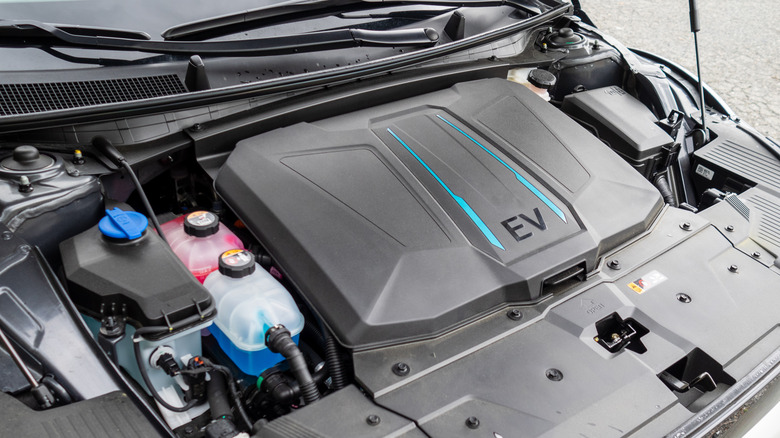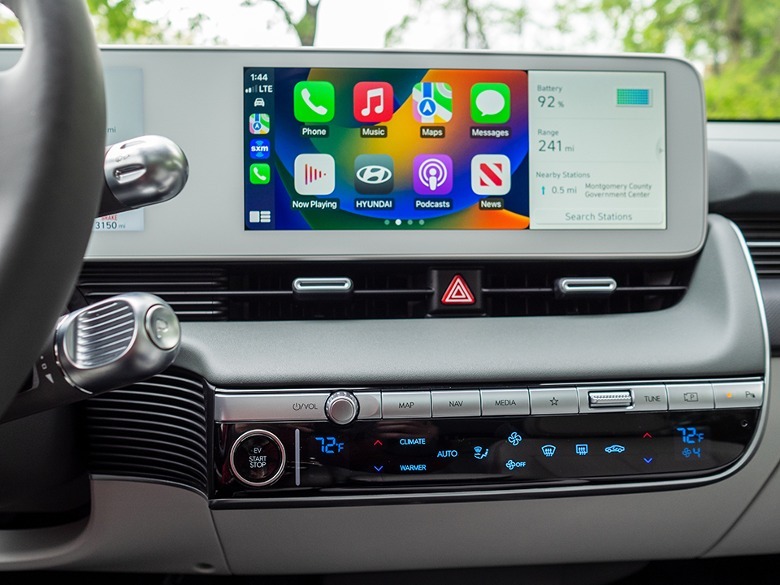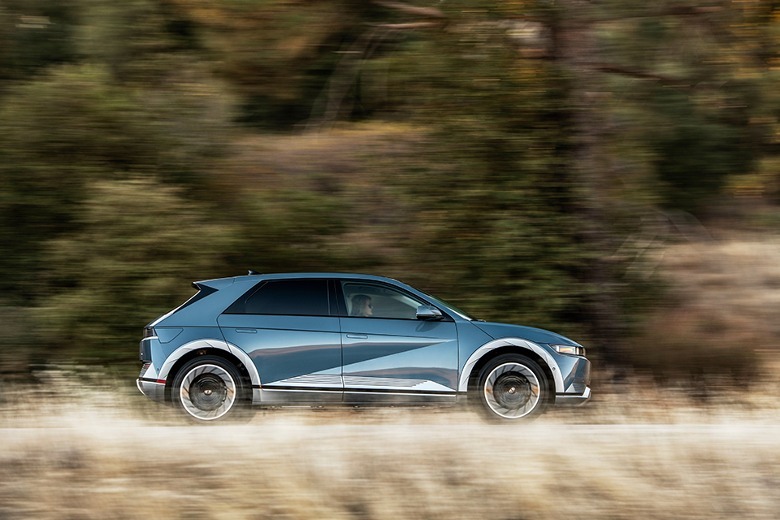2023 Hyundai IONIQ 5 Review: A Cool EV In Search Of A Plug
- Outstanding looks make this EV stand out from the crowd
- Sport mode is genuinely fast
- Can charge to 80% in around 14 minutes on the fastest chargers
- Nothing like hearing the wind instead of the usual engine sounds
- No rear window wiper is odd
- Rear-drive version offers better range
- Color palette needs more color
- No wireless Apple CarPlay or Android Auto
- Infrastructure still falls short
Not too long ago, I reviewed my very first plug-in vehicle, the 2023 Mitsubishi Outlander PHEV. Being a plug-in hybrid, I could have gone without charging the battery pack the entire time the crossover was with me: or, at least, let the gasoline engine do all the charging. Instead, I plugged the Mitsubishi in at one of the EVgo charging stations not from my Virginia home, to give the battery all the juice it needed to run silently while taking Mom to and from work. A practice run for the day I would spend some quality time with a battery electric vehicle, if you will.
That day arrived sooner than expected, with a road trip to North Carolina to try out the 2023 GMC Canyon AT4X and 2024 Chevrolet Trax (plus a surprise first look at the 2024 GMC Sierra HD AT4X). My 1997 Toyota RAV4 was not in any shape to make the trip, as it needed some serious rust repair first. Thankfully, an EV arrived at the body shop to fill-in for the now-classic compact crossover: the 2023 Hyundai IONIQ 5 Limited AWD.
You probably won't be surprised to hear that there's a difference between an old RAV4 and a new IONIQ 5. The question I needed answering, though, was what it would be like to live with an EV for a week, and, perhaps, beyond. What better way, then, than to take the Hyundai on a round trip to North Carolina.
From a single car to an all-EV sub-brand
The IONIQ story will sound familiar to fans of Hyundai's luxury brand, Genesis. In January 2016, the Hyundai IONIQ debuted in its native South Korea as a compact five-door liftback. It was Hyundai's first vehicle built specifically to be either a hybrid, a PHEV, or a BEV. The 2017 – 2019 IONIQ Electric was not only Hyundai's most efficient vehicle in the lineup, but the EPA's with an average MPGe of 136 miles. Total range was 124 miles to start, before gaining a bigger battery to increase its range to 170 miles for the 2019 through 2022 models. The single-generation IONIQ did fairly well in its short time on the showroom floor, with 325,500 units in all flavors sold worldwide. Thanks in part to limited availability in the United States, though, just over 60,000 copies hit the open road in the same time period.
As Hyundai did with the Genesis Coupe and Genesis Sedan, though — spin-off the Genesis name into its own brand — so the company did with the IONIQ name by turning it into its EV-focused sub-brand in 2020, with the aim of 1 million EVs sold annually by 2025. Thus far, the IONIQ line includes the IONIQ 5 compact crossover, the IONIQ 6 midsize sedan, and the upcoming IONIQ 7 midsize crossover. The first of these, the IONIQ 5, was revealed back in late February 2021, taking its design inspiration from the Hyundai Pony, the company's first mass-produced and exported vehicle. The compact crossover made its U.S. debut in May of 2021, going on sale at the end of the year as a 2022 model.
Dual motors deliver on power, but at a price
There are four trim levels available for the 2023 IONIQ 5: SE Standard Range, SE, SEL and Limited. The SE Standard Range comes with one powertrain, in the form of a 125-kW electric motor good for 168 horsepower and 258 lb-ft of torque. The remaining three trims can be had with two powertrain options: a rear-driven unit motivated by a 168-kW electric motor making 225 horses and 258 lb-ft of torque, or an all-wheel drive system comprised of a 74-kW motor paired with a 165-kW motor for a combined 320 horsepower with 446 lb-ft of instantaneous tummy-turning torque. All trims deliver the power to the 19- or 20-inch alloy wheels (the latter exclusive to the Limited trim) through a single-speed reduction gear transmission.
How far can you go in a 2023 Hyundai IONIQ 5? Depends on the trim. The SE Standard Range averages 220 miles on a single charge (249 miles in-town, 185 on the highway). The rest of the rear-drive variants go much further thanks to a bigger battery: 344 miles in the city, 254 miles on the open road, and 303 miles combined.
The all-wheel drive variants, however, suffer a big dent in range for having that second motor drinking from the lithium-ion lake: a combined 266 miles on a single charge (293 miles running those errands at home, 233 miles on those road trips out of town). If you're on a budget, then the SE Standard Range will be just fine. If you have more funds to spare, then it's a matter of selecting the right powertrain for your needs: more range for the road warrior, or more power for the local drag strip night.
Tech delights await inside, minus wireless infotainment
As is befitting a cutting-edge EV like the 2023 Hyundai IONIQ 5, there's a stunning two-screen display along the dash. Thankfully, it's nowhere near as overwhelming as the Mercedes-Benz Hyperscreen. Instead, a pair of 12.3-inch displays housed in a single bezel greet you and your passengers. The center display includes Apple CarPlay and Android Auto plus a 90-day trial of SiriusXM premium, of course. However, it also includes a smaller window displaying everything from the time — in the IONIQ's "Parametric Pixel" design language — to, as shown above, how much battery power and range is left, as well as the nearest charging station. Alas, no wireless Apple CarPlay or Android Auto, which is an interesting omission on a vehicle such as this; you can charge your iPhone or Pixel wirelessly, though.
If you want a heads-up display, you will need to jump to the top-of-the-line Limited trim, as it's the only one with a HUD (one with augmented reality features, at that). The driver's 12.3-inch display behind the HUD (or where one would be if you opt for a lower trim level) has a few neat features, such as Hyundai's blind-spot view monitor for when making a turn, as well as displaying vehicles around you as eraser-like objects.
Hyundai's SmartSense safety suite has it all, from 360-degree views for parking in tight spots to keeping you in your lane at a safe distance via lane-keeping assist and adaptive cruise control. Bose premium audio fills the cabin with all the glorious sounds you could want, especially since you won't hear much else from the IONIQ 5.
A comforting retrofuture lives here
If you're a child of the Eighties or Nineties, then this profile shot should hit some memories for you. As stated earlier, the 2023 Hyundai IONIQ 5's styling is derived from the automaker's first mass-produced export, the Pony (a car whose original concept from 1974 inspired the hydrogen-powered N Vision 74). Personally, it reminds me of other hatchbacks from the era, like the Dodge Omni/Plymouth Horizon and the Volkswagen Golf, particularly in the C pillar; it's comfortingly retro.
The geometric cuts and shapes throughout the body and wheels, combined with the Parametric Pixel head and taillights, give the IONIQ 5 a presence few vehicles can match. And though it looks good in silver and gray with a white and gray interior, the color palette could use some more... color. The IONIQ 6 comes in red, after all.
If there's one thing about EVs, it's how the packaging results in a more open interior. The IONIQ 5's E-GMP platform offers plenty of space for five, as best noted by the very open center console armrest between the two front buckets. You don't need to lift the arm to stow away a purse or camera, that's for sure. Those Hi-Tex-trimmed buckets – featuring more Parametric Pixel shoutouts, by the way — in the Limited trim are not only heated and ventilated, but feature 8-way power-adjustment. Meanwhile, the 60/40 split rear folds down for up to 59.3 cu. ft. of cargo space, 27.2 cu. ft. with the seats up. That's more than enough space for anything from the weekly groceries to a ton of recycling.
Fast charging, if you can find it
Though the intent of EV charging is for most of it to occur at home, some owners may need to charge elsewhere. Like me. My home doesn't have a place for charging overnight, so I must rely on fast-charging stations around town. Not too big a deal, though mileage will vary depending on where you live and what the infrastructure looks like. 2023 Hyundai IONIQ 5 owners do receive two years of complementary 30-minute charging from Electrify America, though my press model, alas, did not come with it.
The real test, however, is taking an EV like the IONIQ 5 on a road trip. Unlike owners of gas- and diesel-powered vehicles who can just pull into the nearest gas station anywhere along the way, EV owners still must plan where to charge their rides. For my trip to North Carolina, there would be at least one stop each way around the halfway point, an Electrify America station in Bristol, Virginia with four 350 kW CCS fast-charging stations. Plugged into one, the IONIQ 5's Limited's 77.4-kWh lithium polymer battery can go from 50% to 80% in around 14 minutes.
There's still a long road ahead for EVs
Unfortunately, I'd have to rely on charging at malls and warehouse stores on the trek. My cabin at "Camp Canyon" in Arden did not have an available hookup for the home charging kit for overnight charging. Meanwhile, the hotel where I stayed in Asheville had charging available for Tesla owners, but no adapter or outlet for the Hyundai. I also discovered that Electrify America places a hold of $50 for 24 hours whenever one of its chargers is used, something I still haven't seen with the EVgo chargers near where I live. Also MIA were receipts from either the Electrify America station in Bristol or the EVgo station in Asheville for using their chargers, despite entering my phone number so a receipt could find its way into my text messages.
Perhaps in isolation, each of those amount to minor annoyances. Collectively, though, it's tough to avoid the conclusion that non-Tesla infrastructure just isn't mature enough, yet. For example, that Bristol stop? It would be the only one between there and Arden/Asheville, as my journey took me south through Tennessee before crossing into North Carolina, all on interstate highways. There's still a long road ahead for EVs and their owners as far as charging speed, availability and reliability are all concerned.
Silent running can be fun
One thing most EVs can do nowadays is keep up with some of the baddest muscle and sports cars around. The instantaneous torque and the whirr of the motors quickly propelling you up to speed remains the sort of thrill that once typically demanded a high-displacement engine. The 2023 Hyundai IONIQ 5 Limited AWD (as well as the SE and SEL AWD trims) make the best use of their 320 horses and 446 lb-ft of torque in Sport Mode, which turns things up to 11 on the highway. It's the perfect mode for blasting by the big rigs in the left lane, for sure. It does, however, use up the most electricity, which may not be so great if you've got a lead foot.
When not passing those aforementioned big rigs between my home and North Carolina, I made the most of Eco Mode, which cuts power to the front motor entirely to deliver the most range. Eco was what helped me make it to Bristol for the single charging stop on the way into Arden, as well as the second stop on the way back. There's also a Normal Mode, which splits the difference between Sport and Eco, and Snow Mode for properly planting the power onto the fresh powder of winter.
Overall, the IONIQ 5 handled the highways and streets quite well. The ride was comfortable and quiet, the rushing wind providing the main soundtrack on the interstates. I managed a final average of 3.5 miles per kWh, which is around 118 MPGe. The only other issue I experienced while on the road is the lack of a rear window wiper, which is not a good thing during a rainstorm or coming straight out of the car wash. The rear heater didn't fix the problem, either. I'm not certain why Hyundai would omit a rear wiper on this crossover, especially when many other crossovers and hatchbacks — including those thousands of dollars less than the base IONIQ 5 — have such a useful tool.
2023 Hyundai IONIQ 5 Verdict
The 2023 Hyundai IONIQ 5 Limited AWD is a fine compact crossover EV with retro-futuristic looks that make it stand out from other vehicles on the road. It's also quite pricey: starting MSRP is $52,600, rising to $59,045 as tested. Those numbers place the EV among competitors like the Ford Mustang Mach-E California Route 1 and GT trims, the Kia GT-Line rear- and all-wheel drive models, and the Volkswagen ID.4 AWD Pro S and AWD Pro S Plus.
The lack of wireless Apple CarPlay/Android Auto, rear wiper, and lower range than on the rear-drive Limited aside, the IONIQ 5 is one of the best EVs out there. The only thing to consider is whether you'd be able to care for one in light of a slow-to-build-out EV charging infrastructure, especially if you can't charge at home. The future is still a work in progress, and it's one where it may be best to opt for hybrid power for the time being. After all, it's easier to find a gas pump than a functional charging station.














